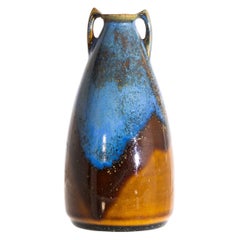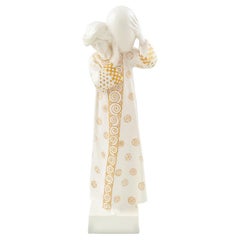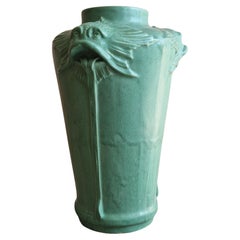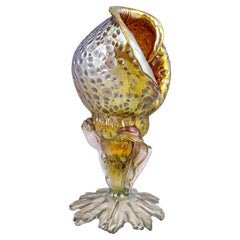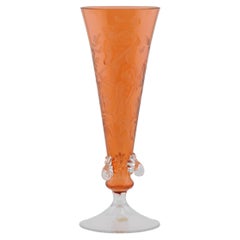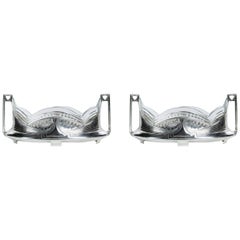Jugendstil Decorative Objects
to
32
206
7
16
190
7
175
8
1
100
29
3
1
2
1
1
26,159
14,109
9,034
5,637
3,854
3,067
2,304
1,696
1,334
1,305
1,139
1,107
985
941
914
665
637
587
134
65
52
40
37
151
32
203
94
71
11
7
Height
to
Width
to
213
206
206
21
19
6
6
5
Style: Jugendstil
Art Nouveau Vase, Jakob Julius Scharvogel '1854-1938', c. 1905/06
By Keramikwerkstatt Johann Julius Scharvogel
Located in Greding, DE
Small vase with smooth walls and handles in shades of blue and brown. On the bottom stamped EL with crown (= Grand Duke Ernst Ludwig) as well as Großherzogliche Keramik Manufaktur Da...
Category
Early 1900s German Antique Jugendstil Decorative Objects
Materials
Ceramic
$1,180 Sale Price
47% Off
Ceramic Sculpture Water Carrier Viennese Secession circa 1903 White Gold
Located in Klosterneuburg, AT
Ceramic sculpture respresenting a Water Carrier - designed by Wilhelm Bormann - manufacture attributed to Ernst Wahliss Wien - Viennese Secession circa 1903 Austrian Art Nouveau - Jugendstil
The Austrian sculptor Wilhelm Bormann studied at the Vienna School of Arts and Crafts from 1898. He worked in the Viennese Mosaic Workshop Leopold Forstner...
Category
Early 1900s Austrian Antique Jugendstil Decorative Objects
Materials
Ceramic, Earthenware
Jugend vase by Karl Svensson, Höganäs, stoneware, Sweden, early 1900's
Located in Stockholm, SE
A very rare fish head vase made by Karl Svensson for Höganäs, Sweden. Made in the early 20th century.
A large true Jugend ceramic vase glazed in green. Adorned with fishes in relief...
Category
Early 20th Century Swedish Jugendstil Decorative Objects
Materials
Ceramic
Conch Shell Glass Vase Iridescent Handmade Loetz Austria Jugendstil circa 1902
By Loetz Glass
Located in Klosterneuburg, AT
Conch Shell Glass Vase Handmade by Johann Loetz Witwe Austria/Bohemia Jugendstil circa 1902 "Diaspora" Decoration
The naturalistically depicted shell and snail vases...
Category
Early 1900s Austrian Antique Jugendstil Decorative Objects
Materials
Art Glass, Blown Glass
Antique/ Vintage Artist Glass Orange Glass Engraved with Farmers Signed by Artis
Located in Amsterdam, Noord Holland
Step into the elegance of this artist engraved glass. Exceptional quality work. The artist thus far remains unidentified, but is of great talent. Possibly used existing glass to engr...
Category
20th Century German Jugendstil Decorative Objects
Materials
Art Glass
Pair of W.M.F. Silver Plate Jardinière, Jugendstil Period, circa 1900
Located in Buenos Aires, Buenos Aires
Pair of W.M.F. silver plate jardinière with glass, Jugendstil period, circa 1900.
Category
Early 1900s German Antique Jugendstil Decorative Objects
Materials
Silver Plate
Early 20th Century Stylish Brass Table Clock in Amsterdamse School Style
Located in Doornspijk, NL
The clear lines and simplicity of this sleek design, together with the craftsmanship by which this clock has been manufactured make this piece stand out.
The oval shaped tumbled foo...
Category
Early 20th Century Dutch Jugendstil Decorative Objects
Materials
Brass
Arts & Crafts Candlestick 1900 Goberg
By Hugo Berger
Located in PARIS, FR
Arts & Crafts / Jugendstil candlestick signed Goberg a German secession Hugo Berger in wrought iron circa 1900. This candlestick has a pretty patina a...
Category
Early 20th Century German Jugendstil Decorative Objects
Materials
Iron
Metal Chandelier Berliner, Electro-Plated-Waren-Fabrik, Germany
Located in Roma, IT
Metal chandelier by Electro-Plated-Waren-Fabrik is an original artwork realized in the 1920s. Early 20th Century
Original silver plated metal.
Realized by Berliner Electro-Plated-W...
Category
Early 20th Century German Jugendstil Decorative Objects
Materials
Metal
19th Century Danish Jugend Copper Candelabras
Located in Esbjerg, DK
Exquisite period detailing on this pair of copper twin - candleholders. Typical elongated organic shapes with smooth curves and age consistent patina. The style is reminiscent to Tho...
Category
Late 19th Century Danish Antique Jugendstil Decorative Objects
Materials
Copper
$1,121 Sale Price / set
20% Off
Jugendstil German Silver Plated Chalice-Shaped Presentation Trophy Vase by WMF
Located in North Miami, FL
Jugendstil/Art Nouveau silver plated chalice-shaped presentation trophy vase by german company Württembergische Metallwarenfabrik (WMF)
By: Würt...
Category
Early 20th Century German Jugendstil Decorative Objects
Materials
Silver, Silver Plate, Metal
Jugendstil Sugar Bowl Brass and Glass Conbination, Around 1908
Located in Wien, AT
Jugendstil sugar bowl brass and glass conbination around 1908.
Brass polished and stove enameled.
Original glass.
Category
Early 1900s Austrian Antique Jugendstil Decorative Objects
Materials
Brass
Bronze Inkwell "Repos" Gustav Gurschner ca. 1900 Austrian Art Nouveau Jugendstil
Located in Klosterneuburg, AT
Inkwell "Repos" (rest), Gustav Gurschner, probably Paris World Exhibition 1900
This bronze inkwell was created in the context of the 1900 ...
Category
Early 1900s Austrian Antique Jugendstil Decorative Objects
Materials
Bronze
$6,203 Sale Price
20% Off
Two Fruit Bowls, circa 1908s
Located in Wien, AT
Two fruit bowls, circa 1908s
Polished and stove enameled.
Category
Early 1900s Austrian Antique Jugendstil Decorative Objects
Materials
Brass
$668 / set
19th C. German Terracotta Sculpture of Resting Lion by Animalier Author A. Gaul
By August Gaul
Located in North Miami, FL
Late 19th century german terracotta sculpture of a resting lion by animalier author August Gaul
By: August Gaul
Material: terracotta
Technique: hand...
Category
Late 19th Century German Antique Jugendstil Decorative Objects
Materials
Terracotta
19th C. Jugendstil German Cut Glass Crystal Inkwell with Polished 800 Silver Lid
Located in North Miami, FL
Late 19th century Jugendstil german cut glass crystal inkwell with polished 800 silver lid
By: unknown
Material: glass, cut glass, crystal, si...
Category
Early 20th Century German Jugendstil Decorative Objects
Materials
Crystal, Metal, Silver, Sterling Silver
Rare jugendstil writing set by Erhard & Sohne Germany
Located in Banská Štiavnica, SK
Rare jugendstil writing set by Erhard & Sohne Germany including letter holder 10x13x6cm, letter dryer 15x8x6cm and knife 18cm long.
Category
Early 1900s German Antique Jugendstil Decorative Objects
Materials
Brass
Crystal Vase Jugendstil Austria circa 1918 Michael Powolny Loetz for Lobmeyr
Located in Klosterneuburg, AT
This elegant object of the Loetz glassworks was produced immediately after the First World War, in the years 1918- 1919. Although stylistic as well as technical recourse to past tech...
Category
1910s Austrian Vintage Jugendstil Decorative Objects
Materials
Glass, Art Glass, Blown Glass
Early 20th C. Czech Footed/Cased Glazed Art Glass Tango Powolny-Like Red Bowl
Located in North Miami, FL
Early 20th century czech cased glazed art glass tango Powolny-like red bowl with foot
By: Michael Powolny (in the style of)
Material: glass, art glass
Technique: cast, polished, glazed, molded
Dimensions: 10 in x 5 in
Date: early 20th century
Style: Jugendstil, Vienna Secession, Art Nouveau
Place of origin: Czech Republic
This unsigned circular wide-brimmed glass bowl features a vibrant reddish-orange glazed top and black pedestal base. Of czech origin, the sleek colorful tango bowl...
Category
Early 20th Century Czech Jugendstil Decorative Objects
Materials
Glass, Art Glass
Brass jewelry box in style of Dagobert Peche and Wiener Werkstätte
Located in Banská Štiavnica, SK
Brass jewelry box in style of Dagobert Peche and Wiener Werkstätte.
Category
Early 1900s Austrian Antique Jugendstil Decorative Objects
Materials
Brass
Stunning Martelé Iridescent Blown Glass Vase by Wilhelm Kralik Sohne
Located in BARCELONA, ES
This Martelé iridescent blown glass vase by Wilhelm Kralik Sohne, Bohemia, represents a pinnacle of craftsmanship and artistic expression from the early 20th century. Known for their...
Category
Early 20th Century Austrian Jugendstil Decorative Objects
Materials
Blown Glass
Sterling Silver Paperweight or Crumb Collector
Located in Alessandria, Piemonte
A/2620. Sterling silver American paperweight: an idea for an elegant gift -
But You can use also as crumb collector...
Very elegant for Your desk.
Category
Mid-20th Century American Jugendstil Decorative Objects
Materials
Sterling Silver
Pair of W.M.F. Silver Plate Jardinière, Jugendstil Period, circa 1900
Located in Buenos Aires, Buenos Aires
Pair of W.M.F. silver plate jardinière with glass, Jugendstil period, circa 1900.
Category
Early 1900s German Antique Jugendstil Decorative Objects
Materials
Silver Plate
Pair of W.M.F. Silver Plate Dishes, Jugendstil Period, circa 1900
Located in Buenos Aires, Buenos Aires
Pair of W.M.F. silver plate dishes, Jugendstil Period, circa 1900.
With hunting dogs.
Category
Early 1900s German Antique Jugendstil Decorative Objects
Materials
Silver Plate
$5,600 Sale Price / set
20% Off
1902 German Jugendstil Presentation Punch Bowl
Located in Austin, TX
Beautifully decorated Jugendstil Presentation Punch Bowl. The vessel is quite large and has a lovely finial lid and detailed vine handles. The inscription is in German which translat...
Category
Early 1900s German Antique Jugendstil Decorative Objects
Materials
Brass, Copper
Set of Two W.M.F. Silver Plate Flower Vases and Jardinière, Jugendstil Period
Located in Buenos Aires, Buenos Aires
Set of two W.M.F. silver plate flower vases and jardinière, Jugendstil period, Germany, circa 1900.
Dimensions of the jardinière: Height 19 c...
Category
Early 1900s German Antique Jugendstil Decorative Objects
Materials
Silver Plate
Franz Xavier Bergmann, Great Dane, Miniature Vienna Bronze Sculpture
Located in New York, NY
Noted for his detailed and colorful work, Bergman was signing his creations with either a "B" in an urn-shaped cartouche, or "Nam Greb" for "Bergman" in reverse (these marks used to disguise his identity on the erotic works). They are also often inscribed ‘Geschutzt’, which refers to the model/design being ‘registered’ or copyrighted; or not marked at all, especially if the pieces are miniatures, circa 1900.
Dimensions:
Height 0.88 inches (2.2 cm)
Width 0.94 inches (2.4 cm)
Depth 2.07 inches (5.2 cm)
Franz Xavier Bergmann...
Category
Early 1900s Austrian Antique Jugendstil Decorative Objects
Materials
Bronze
Pair of Bruno Paul Bronze Articulating Candelabras
By Bruno Paul
Located in Chicago, IL
Pair of Bruno Paul Articulating candelabras
These are unmarked. Uncertain if they are German by Bruno Paul or if possibly by the Anderson Foundry executed in the early 20th century....
Category
Early 20th Century Jugendstil Decorative Objects
Materials
Brass
Alfonso Canciani, Viennese Secession Orientalist Bronze Vase, c. 1910
Located in New York, NY
Alfonso Canciani (Italian-Austrian, 1863-1955) was a famous Italian-Austrian sculptor of the period of accession to the Viennese Secession. Son of a stonemason, after a realist period he managed to establish himself as a leading sculptor of the Viennese Secession. In fact, he worked in Vienna, where he had enrolled in 1886 at the Academy of Fine Arts, then at the Higher School of Sculpture and finally at the Special School, where he obtained the Rome prize for the sketch for Dante's Monument.
He developed a notable business obtaining important prizes and numerous commissions. First among the sculptors of the Viennese capital, he was invited to join the Association of the Viennese Secession, of which Klimt was magna pars, after the exhibition of Dante's group in 1900 at the Secession exhibition, and obtained the most important Austrian artistic prize, the Kunstlerlpreis.
This same work, presented in 1910 in Berlin, at the Great Art Exhibition, also received an important recognition here. He obtained the Rome prize in 1896, exhibited successfully in Munich and in 1899 at the III International Art Exhibition in Venice.
In that period he made some statues of saints for the cathedral of Santo Stefano in Vienna, the monument to Wagner, the bust of Nietzsche for the University, the scepter and the gold chain of the University Rector, figures of Italian poets ( Petrarch, Boccaccio, Tasso, Ariosto).
He submitted a sketch for the official monument to Empress Elizabeth, which was then built in Austrisn Gföhl and Pula. At the time of his accession to the Secession, he dedicated himself to decorating the facade of the Artaria house in Vienna in collaboration with the architect Max Fabiani.
He later abandoned the symbolist decorativism of the Jugendstil for a more concentrated and vigorous style, approaching the Belgian sculptor Constantin Meunier for the theme of work, and preferring to exhibit at the Künstlerhaus.
In Vienna, he was generous with advice and help with the Italians and in particular with his fellow citizens (such as the Brazzanese Luigi Visintin, then a university student).
After the First World War, he returned to Italy and lived in Friuli, penalized by the fact that the Habsburg Empire had by now disappeared. Instead of large-scale public monuments, he then devoted himself to engraving medals (e.g. for Benedict XV and for the Italian mission in Vienna in 1919) and to designing funeral monuments (examples in Mali Lošinj and Trieste) and portrait busts (of Generals Carlo Caneva and Antonio Baldissera in Udine, sculptures of the War Memorial of Corno di Rosazzo). After all, he had already executed the Bab grave monument in the Döblinger cemetery in Vienna in 1909.
He taught in Trieste from 1920 until 1935, at the local school of industrial art, where he had Marcello Mascherini...
Category
1910s Austrian Vintage Jugendstil Decorative Objects
Materials
Bronze
Pair of W.M.F. Silver Plate and Gilt Bronze Jardinière, Jugendstil Period
Located in Buenos Aires, Buenos Aires
Pair of W.M.F. Silver plate and gilt bronze jardinière, Jugendstil period. Germany, circa 1900.
Category
Early 1900s German Antique Jugendstil Decorative Objects
Materials
Silver Plate, Bronze
Austrian Jugendstil Vienna Bronze Sculptural Paperweight by Carl Fiala, ca. 1910
Located in New York, NY
ABOUT
This elegant Austrian Jugenstil sculptural desk paperweight depicts some fantastic half-human creature from the underwater world, riding a snail. Signed C. Fiala, dark-green co...
Category
1910s Austrian Vintage Jugendstil Decorative Objects
Materials
Bronze
Iridescent Glass and Silver Plate Vase, Germany, circa 1910
Located in Buenos Aires, Buenos Aires
Iridescent glass and silver plate vase. Germany, circa 1910.
Category
1910s German Vintage Jugendstil Decorative Objects
Materials
Silver Plate
Yellow Copper Bowl, Signed F Z. 'Frans Zwollo sr.'
Located in Esbeek, NL
Yellow copper bowl in a shape of a lotus.
The bowl is signed by Frans Zwollo sr.(1872-1945), by the design of Lion Cachet (1864-1945)
Both were members ...
Category
20th Century Dutch Jugendstil Decorative Objects
Materials
Silver, Copper
Jugendstil decorative objects for sale on 1stDibs.
Find a broad range of unique Jugendstil decorative objects for sale on 1stDibs. Many of these items were first offered in the 21st Century and Contemporary, but contemporary artisans have continued to produce works inspired by this style. If you’re looking to add vintage decorative objects created in this style to your space, the works available on 1stDibs include decorative objects, serveware, ceramics, silver and glass, building and garden elements and other home furnishings, frequently crafted with metal, brass and other materials. If you’re shopping for used Jugendstil decorative objects made in a specific country, there are Europe, Austria, and Germany pieces for sale on 1stDibs. While there are many designers and brands associated with original decorative objects, popular names associated with this style include WMF Württembergische Metallwarenfabrik, Loetz Glass, Franz Bergmann, and Woka Lamps. It’s true that these talented designers have at times inspired knockoffs, but our experienced specialists have partnered with only top vetted sellers to offer authentic pieces that come with a buyer protection guarantee. Prices for decorative objects differ depending upon multiple factors, including designer, materials, construction methods, condition and provenance. On 1stDibs, the price for these items starts at $156 and tops out at $800,000 while the average work can sell for $2,100.
Recently Viewed
View AllMore Ways To Browse
Gold Gilt Altar
Ming Dynasty 18th Century
Hon Furniture
Le Roy Paris
Mantle Urns
Millefiori Antique
Italian Bronze Clock
Majolica Rooster
Mantel Chime Clock
Italian Cigarette Case
Italian Crucifix
Mayan Mid Century
Gold Squirrel
Hamada Shoji
Large German Porcelain Figure
Metal Cigarette Case
Marble Torchere
Italy Tazza
